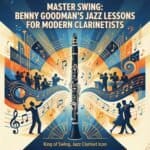What is jazz clarinet? Jazz clarinet is the use of the B-flat clarinet and related soprano clarinets as lead and improvising instruments in jazz. It began in New Orleans in the 1910s, peaked in the swing era of the 1920s-1940s, highlighted by Benny Goodman's 1938 Carnegie Hall concert, and continues in modern creative jazz with extended techniques and experimental timbres.
Origins: How the Clarinet Entered Jazz (New Orleans, 1910s)
Jazz clarinet emerged in New Orleans around the 1910s, when the clarinet joined cornet, trombone, and rhythm section in early dance bands and street parades. Its agile high register and vocal slides made it ideal for weaving countermelodies above Louis Armstrong-style trumpet lines and tailgate trombone, helping define the classic New Orleans ensemble sound.
In Storyville and neighborhood social clubs, clarinetists such as Johnny Dodds, Jimmie Noone, and Sidney Bechet adapted European-trained technique to African American blues phrasing and Caribbean rhythmic feel. The clarinet often played the obbligato line, filling spaces between vocal phrases and horn riffs, a role that would shape jazz phrasing for decades.
New Orleans clarinet style grew from brass band traditions, opera house pit orchestras, and Creole dance music. Players blended marches, ragtime, quadrilles, and blues into a flexible language of ornaments, bends, and expressive vibrato. This mixture created the first distinct jazz clarinet dialect, heard later on Chicago and New York recordings of the 1920s.
Sidney Bechet, though later famous on soprano saxophone, began as a clarinetist and carried clarinet-style vibrato and portamento into his sax playing. His early work in New Orleans and with Will Marion Cook's Southern Syncopated Orchestra in Europe showed how clarinetists could be star soloists, not just ensemble voices.
Migration patterns after World War I moved many New Orleans musicians, including clarinetists, to Chicago. There, recording technology and the growing record industry captured their styles. These discs became the reference library for later jazz clarinetists studying early phrasing, tone, and ensemble roles.
Timeline of Eras: Early Jazz -> Swing -> Bebop -> Modern Creative Jazz (key dates: 1910s, 1920s-1930s, 1940s-1950s, 1960s-Present)
Jazz clarinet history follows the major eras of jazz itself, but with its own peaks and valleys. Understanding this timeline helps players and researchers connect specific sounds and techniques to particular decades, recordings, and social contexts.
Early Jazz and New Orleans/Chicago (1910s-1920s)
In the 1910s, the clarinet was a core voice in New Orleans ensembles, often playing high, decorative lines. By the early 1920s, Chicago studios recorded bands featuring Johnny Dodds, Jimmie Noone, and others. Their work with King Oliver, Louis Armstrong, and Jelly Roll Morton documented the first widely distributed jazz clarinet solos.
These early recordings show the clarinet as a flexible bridge between the lead cornet and the rhythm section. The sound is bright, penetrating, and vocal, with wide vibrato, scoops, and blues inflections. For historians, this era anchors the clarinet's foundational role in jazz texture and improvisation.
Swing Era and Big Bands (1920s-1930s)
By the late 1920s and 1930s, the clarinet moved from small combo countermelody to big band spotlight. Benny Goodman, Artie Shaw, and Woody Herman became household names, and the clarinet often fronted entire orchestras. The instrument symbolized swing itself for many listeners.
Goodman's technical precision, Artie Shaw's lyricism, and Jimmy Hamilton's refined tone with Duke Ellington showed different ways the clarinet could lead. Arrangers wrote clarinet features, and the instrument often introduced themes, played shout choruses, or delivered cadenza-like openings and endings.
Bebop and Postwar Shifts (1940s-1950s)
In the 1940s, bebop changed the jazz language. Saxophones, especially alto and tenor, became the main voices for the new, faster, harmonically dense style. Clarinet's narrow bore and resistance made extreme bebop tempos and altissimo lines more demanding, so fewer players took it up as a primary bebop horn.
Buddy DeFranco became the leading bebop clarinetist, translating Charlie Parker-inspired lines to the instrument with remarkable fluency. Jimmy Giuffre explored cool jazz, counterpoint, and chamber-like textures, showing that clarinet could thrive in more intimate, experimental settings beyond big band swing.
Modern Creative Jazz and Beyond (1960s-Present)
From the 1960s onward, jazz clarinet re-emerged in avant-garde, free jazz, and world-influenced projects. Eric Dolphy, while better known for bass clarinet, expanded the clarinet family in modern jazz. Later, players like Don Byron, Louis Sclavis, and Anat Cohen embraced both historical styles and contemporary composition.
Modern creative jazz clarinet often includes extended techniques, microtones, and cross-genre collaborations. Players might reference New Orleans polyphony in one piece, then use multiphonics and unusual timbres in another, creating a continuous thread from 1910s street parades to 21st-century concert halls and clubs.
Iconic Clarinetists and Landmark Performances (Sidney Bechet, Benny Goodman – 1938 Carnegie Hall, Artie Shaw, Johnny Dodds, Jimmie Noone, Jimmy Hamilton, Pee Wee Russell, Buddy DeFranco, Jimmy Giuffre, modern players)
Jazz clarinet history is best understood through its key players and their signature recordings. Each clarinetist below represents a specific sound, era, and approach to improvisation that students and researchers can study in detail.
Sidney Bechet: Early Virtuoso Voice
Sidney Bechet, born in New Orleans in 1897, was a clarinet prodigy before turning primarily to soprano saxophone. His clarinet playing featured wide, emotional vibrato, strong blues phrasing, and dramatic rhythmic drive. Early recordings with Clarence Williams and others capture his intense, vocal clarinet sound.
Even when he switched to soprano sax, Bechet's phrasing remained rooted in clarinet technique. For jazz clarinetists, his work demonstrates how to project personality through vibrato, dynamic contrast, and bold melodic shapes. His career also shows the early international spread of jazz, including tours in Europe in the 1910s and 1920s.
Johnny Dodds and Jimmie Noone: New Orleans to Chicago
Johnny Dodds, known for his work with King Oliver and Louis Armstrong, brought a powerful, penetrating tone and strong blues language. His solos on recordings like “Dipper Mouth Blues” and “Wild Man Blues” are important study material for early jazz clarinet articulation and phrasing.
Jimmie Noone led his own small groups in Chicago, featuring a smoother, more legato style. His playing on tracks such as “Four or Five Times” shows elegant melodic lines, clear enunciation, and a refined approach to swing. Together, Dodds and Noone define two poles of early jazz clarinet sound: raw and earthy versus polished and lyrical.
Benny Goodman and the 1938 Carnegie Hall Concert
Benny Goodman, born in 1909 in Chicago, became the most widely known jazz clarinetist of the swing era. His 1938 Carnegie Hall concert is a landmark event in jazz history, often cited as a moment when jazz gained recognition on a major classical stage.
Primary documentation of the concert includes the original Carnegie Hall program and later Columbia Records releases. The performance featured Goodman's orchestra, small groups, and guests like Count Basie band members. His playing on pieces such as “Sing, Sing, Sing” showcases technical control, clear tone, and driving swing feel.
For students, transcribing Goodman's solos from this concert provides insight into swing-era phrasing, arpeggio-based lines, and use of the clarinet's full range. Historians often consult Carnegie Hall archives and contemporary press reviews to understand the concert's cultural impact and reception.
Artie Shaw, Jimmy Hamilton, and Pee Wee Russell
Artie Shaw combined virtuosic technique with a strong interest in composition and orchestration. His recording of “Begin the Beguine” became a major hit, and his clarinet sound leaned toward a dark, centered tone with smooth legato. Shaw's work shows how clarinet could lead a band with both commercial appeal and musical depth.
Jimmy Hamilton, a key member of Duke Ellington's orchestra, brought classical-level control to jazz clarinet. His precise articulation, even tone, and tasteful improvisations on Ellington suites illustrate a more restrained but highly musical approach, ideal for studying blend and section playing as well as solo work.
Pee Wee Russell, associated with Eddie Condon and traditional jazz circles, developed a highly personal, sometimes abstract style. His lines often twist and turn unpredictably, foreshadowing aspects of modern jazz. Russell demonstrates that individuality of phrasing and timbre can be as important as technical polish.
Buddy DeFranco and Jimmy Giuffre: Modernizing the Clarinet
Buddy DeFranco translated bebop vocabulary to the clarinet in the 1940s and 1950s. His recordings with small groups show rapid lines, sophisticated harmonic understanding, and clean articulation at high tempos. DeFranco is a primary reference for players wanting to apply Charlie Parker and Dizzy Gillespie language to clarinet.
Jimmy Giuffre explored cool jazz, counterpoint, and free improvisation. His work with the Jimmy Giuffre 3, including albums like “Fusion” and “Thesis,” uses clarinet in intimate, drumless settings. Giuffre's tone is often soft and breathy, with subtle dynamics and phrasing, offering a contrasting model to high-energy bebop clarinet.
Modern Players: Don Byron, Anat Cohen, and Others
Don Byron brought clarinet to the center of 1990s and 2000s creative jazz, blending klezmer, swing, modern composition, and political themes. His albums dedicated to Mickey Katz and other historical figures show how clarinet can connect archival research and contemporary improvisation.
Anat Cohen has become one of the most visible modern jazz clarinetists, combining Brazilian music, swing, and original compositions. Her tone is warm and flexible, and her improvisations balance melodic clarity with rhythmic sophistication. Other notable modern players include Louis Sclavis, Ken Peplowski, and Evan Christopher, each contributing distinct regional and stylistic flavors.
Core Jazz Clarinet Techniques and Practice Drills (vibrato, articulation, slides/bends, phrasing, multiphonics)
Core jazz clarinet techniques grow directly from the instrument's historical roles. Early New Orleans and swing players used vibrato, scoops, and flexible articulation to imitate the human voice, while modern players add extended techniques and complex phrasing. Focused drills help turn these sounds into reliable tools.
Vibrato: From Early Jazz to Modern Styles
Jazz clarinet vibrato can be jaw-based, breath-based, or a combination. Early players like Sidney Bechet and Johnny Dodds used wide, fast vibrato, while swing-era players often favored a narrower, more controlled version. Modern players may vary vibrato width and speed to match style and emotional content.
Practice drill: Sustain a written G in the staff for 8 counts with no vibrato, then add slow jaw vibrato at 4 pulses per beat. Gradually increase to 6 or 8 pulses per beat, then practice crescendos and decrescendos while keeping vibrato even. Record yourself and compare to historical recordings you admire.
Articulation: Swing, Ghosting, and Accents
Jazz clarinet articulation shapes the groove. Swing-era players used a mix of legato tonguing, light “doo” syllables, and ghosted notes to create forward motion. Early New Orleans styles often emphasize accented upbeats and slightly separated notes to cut through ensemble textures.
Practice drill: Take a simple scale in eighth notes at medium tempo. Tongue every note with a light “doo.” Then, slur pairs of notes, tonguing only the offbeats. Finally, ghost every second note by playing it softer and slightly shorter. Apply the same patterns to a transcribed jazz phrase.
Slides and Bends: Vocal Inflection
Slides and bends imitate singers and horn players like Louis Armstrong. On clarinet, these effects come from finger coordination, embouchure flexibility, and air support. Early jazz players used slides to enter notes from below, while swing players often used subtle scoops at phrase beginnings.
Practice drill: Choose a written D in the staff and slowly slide up to it from a half step below by loosening the embouchure and rolling the lower lip slightly forward, then firming to center the pitch. Repeat on different notes. Next, practice small scoops into the first note of each bar in a simple melody.
Phrasing and Time Feel
Jazz clarinet phrasing combines note length, dynamics, and rhythmic placement. Early jazz often leans slightly behind the beat with long, singing lines, while bebop clarinet may sit more on top of the beat with intricate subdivisions. Listening to recordings is important for internalizing these nuances.
Practice drill: Take a four-bar phrase from Benny Goodman or Artie Shaw and play it with a metronome on beats 2 and 4. First, match the written rhythm exactly. Then, experiment with slightly delaying phrase endings, adding small dynamic swells, and shaping the line as if you were singing lyrics.
Intro to Multiphonics for Jazz Context
Multiphonics, where more than one pitch sounds at once, are more common in modern creative jazz than in early styles. They can add tension, color, and dramatic effects in solos or free improvisations. Achieving reliable multiphonics requires precise voicing and embouchure control.
Practice drill: Start with a known, relatively easy multiphonic fingering from a fingering chart or contemporary method. Sustain it at soft dynamics, focusing on stable air. Then, experiment with crescendo and decrescendo, slight pitch bends, and transitions into and out of the multiphonic from a normal note.
Extended Techniques & Modern Creative Uses (flutter tonguing, glissandos, multiphonics, experimental timbres)
Modern creative jazz clarinet uses extended techniques to expand the instrument's expressive range. These sounds are not just special effects; they can become core vocabulary in free improvisation, contemporary composition, and cross-genre collaborations.
Flutter Tonguing and Growls
Flutter tonguing produces a rapid, rolled sound by vibrating the tongue or uvula while blowing. Growls combine air and vocal cord vibration, creating a rough, bluesy timbre. Both techniques add intensity and can highlight climactic moments in solos.
Practice drill: Start with a soft, steady note in the middle register. Add a light tongue roll (as in rolled “r” sounds) while maintaining embouchure stability. For growls, hum a low pitch while playing a note, adjusting until both sounds blend. Use these effects on long notes at phrase peaks.
Glissandos and Smears
Clarinet glissandos became famous through Gershwin's “Rhapsody in Blue” and are also used in jazz. They combine rapid finger motion with embouchure and voicing adjustments to slide smoothly between notes, especially across the break. In jazz, glissandos can dramatize entrances or connect wide intervals.
Practice drill: From low E to high C, practice a slow, fingered scale while gradually loosening the embouchure and voicing to smooth the transitions. Then, speed up the finger movement while maintaining the slide effect. Apply shorter glissandos between chord tones in a blues or standard tune.
Advanced Multiphonics and Split Tones
Beyond basic multiphonics, modern players use split tones, where a normal note partially breaks into an overtone, and complex chord-like sounds. These techniques often appear in free jazz and contemporary classical-influenced improvisation, adding texture and harmonic ambiguity.
Practice drill: Choose a stable note and gradually increase air pressure while slightly loosening the embouchure until an overtone starts to emerge. Alternate between the pure tone and the split tone. Then, integrate this effect at the end of long notes or as a surprise within a phrase.
Breathy Tones, Subtones, and Air Sounds
Some modern clarinetists use intentionally breathy tones, subtone (very soft, covered sound), and pure air sounds without pitch. These timbres can create contrast with traditional full tone and support narrative or atmospheric improvisations.
Practice drill: Play low register notes at the softest possible dynamic while keeping them stable. Gradually allow more air noise into the sound by relaxing the embouchure and reducing reed contact. Then, try producing only air sounds with key clicks, using them as rhythmic elements.
Instrument Anatomy & Choosing a Jazz Clarinet (basic bore/reed/mouthpiece considerations – note: avoid brand promotion except in historical context)
Understanding clarinet anatomy helps players choose setups that support their preferred jazz sound. While the standard jazz instrument is the B-flat clarinet, variations in bore, mouthpiece, and reed strength can significantly affect tone, response, and flexibility for techniques like bends and altissimo playing.
Clarinet Family and Bore Considerations
The B-flat soprano clarinet is the primary jazz instrument, though A clarinets, E-flat clarinets, and bass clarinets also appear in some styles. Bore size and shape influence resistance and tone color. Slightly larger bores often yield a broader, more open sound, while smaller bores can feel more focused and resistant.
For jazz, many players prefer instruments that respond easily in the altissimo register and allow flexible pitch shading. This helps with bends, scoops, and expressive intonation. Trying different instruments in live playing situations, not just practice rooms, gives a clearer sense of how bore and response match your style.
Mouthpiece Design and Facing Length
Mouthpiece design, including tip opening and facing length, strongly affects jazz tone and articulation. More open tips with longer facings often allow a bigger, more flexible sound, suitable for expressive vibrato and dynamic range. More closed tips can feel stable but may limit extreme color changes.
When choosing a mouthpiece for jazz, test how it handles loud dynamics, soft subtone, and quick articulation. Play transcribed solos that include both legato lines and accented figures. A good jazz mouthpiece should let you move between warm, covered tone and brighter, projecting sound without strain.
Reed Strength and Cut for Jazz Playing
Reed strength and cut shape response and color. As a general guideline, many jazz clarinetists use reed strengths between 2.5 and 4, depending on mouthpiece opening and embouchure. Slightly softer reeds can make bends, vibrato, and altissimo easier, while slightly harder reeds can support a more focused, stable tone.
Experiment with different cuts to find a balance between quick response and tonal depth. Practice long tones, scales, and a favorite solo on each reed. Note which reeds allow you to play softly without losing core and loudly without spreading. Keep a reed journal to track which strengths and cuts work best in rehearsals and performances.
Keywork, Register Mechanism, and Ergonomics
Keywork design affects technical facility, especially in fast bebop lines and altissimo passages. Smooth, well-adjusted keys help avoid unwanted noise and resistance. The register key and throat tone venting are particularly important for clean transitions across the break and into higher registers.
When testing an instrument, play rapid arpeggios across the break, chromatic scales into altissimo, and repeated patterns in the right-hand keys. Check that the pinky keys feel comfortable and that your hand position remains relaxed. Good ergonomics reduce fatigue during long sets and demanding solos.
Maintenance and Workshop Steps for Clarinetists (routine checks, reed care, basic troubleshooting steps)
Reliable jazz clarinet performance depends on consistent maintenance. Regular care reduces squeaks, improves response, and prevents mid-gig mechanical failures. A simple schedule of daily, weekly, and monthly tasks keeps the instrument ready for both practice and performance.
Daily Care: Swabbing, Reed Rotation, and Case Habits
After each playing session, swab the bore thoroughly to remove moisture. Wipe the mouthpiece with a soft cloth and avoid using hot water that can warp it. Rotate between at least 3 to 4 reeds, allowing each to dry flat between uses to extend lifespan and maintain consistent response.
Store the clarinet in its case when not in use, avoiding extreme temperature and humidity changes. For players in dry climates, consider a small case humidifier to reduce cracking risk. Check that joints fit snugly but not tightly, and avoid forcing tenons together if they feel stuck.
Weekly Checks: Key Motion and Pad Surfaces
Once a week, inspect key motion and pad surfaces. Gently move each key to feel for sluggishness or excess play. Check pads for visible damage, deep impressions, or moisture stains. Lightly clean key surfaces and tone hole rims with a soft, lint-free cloth.
If keys feel noisy, a tiny amount of appropriate key oil at pivot points can help, but avoid over-oiling. Test all notes chromatically from low E to altissimo, listening for uneven response or sudden resistance. Note any problem areas for focused troubleshooting or technician visits.
Monthly Inspection: Pads, Corks, and Alignment
Each month, perform a more detailed inspection. Look closely at tenon corks for compression or cracking that could affect joint fit. Check that bridge keys align correctly between upper and lower joints. Use a leak light, if available, to identify pads that do not seal fully.
Gently test spring tension by lifting and releasing keys. Springs that feel too weak or too strong can affect technique and intonation. While major adjustments are best left to a qualified technician, identifying issues early prevents sudden failures during rehearsals or performances.
Basic Workshop Triage for Jazz Players
Jazz clarinetists often need quick fixes between sets. A basic triage kit might include cigarette paper or pad cleaning paper, a small screwdriver, key oil, cork grease, and spare reeds. Use papers to clean sticky pads by placing them under the pad, closing the key, and gently pulling out.
For minor screw backing, carefully tighten pivot screws just enough to remove wobble without binding keys. If a note suddenly stops speaking, check for obvious pad leaks, misaligned bridge keys, or loose joints. If the problem persists, switch to a backup instrument rather than forcing a risky repair on stage.
Troubleshooting Common Problems (response, squeaks, intonation, sticky keys) with stepwise checks
Common clarinet problems often have simple causes. A stepwise troubleshooting approach saves practice time and reduces frustration. Many issues relate to reed condition, assembly, or minor mechanical problems that players can address themselves before visiting a technician.
Squeaks: Reed, Embouchure, or Assembly
Squeaks usually result from reed issues, embouchure instability, or misaligned assembly. Start by inspecting the reed for chips, warping, or waterlogging. Ensure it is centered on the mouthpiece with equal overhang on both sides and that the ligature is secure but not overly tight.
Next, check your embouchure: firm but not biting, with steady air support. Practice long tones at soft dynamics to stabilize control. Finally, verify that joints are fully assembled, bridge keys are aligned, and no keys are accidentally held down by fingers or clothing.
Poor Response in Upper Registers
If upper register notes feel resistant or unstable, first confirm that the reed is not too soft or too hard for your setup. Try a slightly stronger reed for more support, or a slightly softer one if the sound feels choked. Ensure the mouthpiece is pushed on to a typical tuning position.
Then, check the register key mechanism and related pads. Light leaks around the register vent or upper joint pads can severely affect high notes. Use a leak light, if available, or gently press around suspect pads while playing to see if response improves. Persistent issues may require professional adjustment.
Intonation Problems: Sharp, Flat, or Unstable Pitch
Intonation issues can stem from instrument setup, reed choice, or playing habits. If you are consistently sharp, pull out slightly at the barrel and consider using a slightly harder reed. If consistently flat, push in and check that your embouchure is not too loose or rolled out.
Work with a tuner to map your instrument's pitch tendencies on each note. Some clarinets have naturally sharp throat tones or flat low notes. Learn to compensate with voicing, alternate fingerings, or small embouchure adjustments. Regular long-tone practice with a drone helps stabilize pitch center.
Sticky Keys and Noisy Mechanism
Sticky keys often come from moisture, residue, or pad surface issues. Use pad cleaning paper or unscented cigarette paper to gently blot pads, especially on G-sharp, side keys, and low joint keys that collect condensation. Avoid using powders that can build up and damage pads.
Noisy keys may indicate dry pivot points or loose screws. Apply a tiny drop of key oil to pivot screws and rods, then work the keys to distribute it. Carefully tighten any visibly loose screws, but stop if keys start to bind. If noise persists, schedule a professional regulation.
Multiphonic Instability and Extended Technique Issues
For players exploring multiphonics and extended techniques, instability often results from inconsistent air support or voicing. Ensure you are using fingerings known to produce reliable multiphonics and start at soft dynamics. Gradually increase volume while maintaining steady air and relaxed throat.
If a multiphonic collapses into a single pitch, experiment with slight changes in tongue position and embouchure pressure. Recording practice sessions helps you identify which combinations of voicing and air yield repeatable results, turning experimental sounds into usable musical tools.
Clarinet in Education, Journalism, and Musicology (teaching the tradition, archival research paths, notable sources)
Jazz clarinet plays an important role in education, journalism, and musicology. Teachers use historical recordings and transcriptions to connect students with tradition, while researchers and writers document the instrument's evolving role in jazz culture, performance practice, and instrument design.
Teaching Jazz Clarinet Tradition
Effective jazz clarinet teaching combines technical exercises with listening and transcription. Instructors often assign recordings by Johnny Dodds, Benny Goodman, Artie Shaw, Buddy DeFranco, and modern players like Anat Cohen. Students learn to imitate tone, articulation, and phrasing before developing their own voices.
Curricula may include New Orleans ensemble roles, swing-era big band parts, bebop language, and modern creative approaches. Ensemble coaching helps clarinetists understand how to blend with saxophones and trumpets, when to take lead roles, and how to support rhythm sections with clear time feel.
Journalism and Criticism on Jazz Clarinet
Jazz journalism documents clarinetists' careers, recordings, and stylistic innovations. Articles in magazines and online platforms often profile players, review albums, and analyze landmark performances such as Benny Goodman's 1938 Carnegie Hall concert. Critics highlight how clarinetists navigate tradition and innovation.
Writers may compare different eras, such as swing versus modern creative scenes, or explore regional styles like New Orleans revival bands and European avant-garde clarinetists. These perspectives help audiences understand the instrument's ongoing relevance and the diversity of its voices.
Musicological Research and Archival Paths
Musicologists studying jazz clarinet draw on a wide range of sources. The Tulane Hogan Jazz Archive in New Orleans preserves oral histories, photographs, and documents related to early jazz musicians, including clarinetists. The Library of Congress holds recordings, manuscripts, and interviews that shed light on performance practice.
The Smithsonian's jazz collections and oral history projects offer interviews with major figures, including clarinetists and bandleaders. Researchers also consult Carnegie Hall archives for materials related to the 1938 Goodman concert, such as programs, reviews, and later reissue documentation, to understand its historical impact.
Instrument collections in museums and private archives allow scholars to examine historical clarinets used in jazz contexts. By measuring bore dimensions, keywork layouts, and material choices, researchers can link physical instrument properties to recorded sounds and documented performance descriptions.
Key Takeaways
- Jazz clarinet originated in New Orleans around the 1910s, peaked in visibility during the swing era, and continues in modern creative scenes with extended techniques and cross-genre collaborations.
- Studying iconic players from Johnny Dodds and Benny Goodman to Buddy DeFranco and Anat Cohen connects historical styles with practical techniques like vibrato, articulation, and phrasing.
- Instrument setup, including mouthpiece, reed strength, and bore characteristics, directly affects jazz tone, flexibility for bends and altissimo, and overall comfort in long performances.
- Regular maintenance and systematic troubleshooting help prevent squeaks, response issues, and mechanical failures, allowing players to focus on musical expression rather than equipment problems.
- Archival resources such as the Tulane Hogan Jazz Archive, Library of Congress, Smithsonian collections, and Carnegie Hall records support deeper historical and musicological research on jazz clarinet.
FAQ
What is jazz clarinet?
Jazz clarinet is the use of the B-flat clarinet and related soprano clarinets as lead and improvising instruments in jazz. It began in New Orleans in the 1910s, became a symbol of the swing era through players like Benny Goodman, and remains active in modern creative, traditional, and world-influenced jazz scenes.
What are the core techniques for playing early jazz on the clarinet?
Core early jazz clarinet techniques include wide, expressive vibrato, flexible articulation with ghosted notes, slides and bends into key pitches, and strong time feel within ensemble polyphony. Studying Johnny Dodds, Jimmie Noone, and Sidney Bechet helps players learn characteristic phrasing, tone color, and ornamentation of New Orleans and Chicago styles.
How did the clarinet become prominent in jazz and what are the key dates?
The clarinet entered jazz in New Orleans around the 1910s as a high, agile voice in small ensembles. It became highly prominent in the 1920s and 1930s swing era, with Benny Goodman's 1938 Carnegie Hall concert as a major milestone. After bebop's rise in the 1940s, clarinet's mainstream role declined but later revived in modern creative and traditional scenes.
How do I practice vibrato, articulation, and slides for jazz clarinet?
For vibrato, practice sustained notes starting straight, then add jaw vibrato at controlled speeds and widths. For articulation, use scale exercises with varied tonguing patterns, ghosted notes, and offbeat accents. For slides, slowly approach target notes from below using embouchure and finger coordination, then apply these effects to transcribed jazz phrases and melodies.
What routine maintenance should jazz clarinetists perform to avoid squeaks and response problems?
Daily, swab the bore, wipe the mouthpiece, and rotate reeds so they dry evenly. Weekly, check key motion and clean pad surfaces. Monthly, inspect pads, corks, and alignment, and test for leaks or sluggish keys. Keeping reeds in good condition and joints properly fitted greatly reduces squeaks and response issues.
Which historic recordings or performances are important for studying jazz clarinet (e.g., Benny Goodman 1938)?
Important listening includes early New Orleans and Chicago recordings with Johnny Dodds and Jimmie Noone, swing-era work by Benny Goodman and Artie Shaw, especially Goodman's 1938 Carnegie Hall concert, and modern recordings by Buddy DeFranco, Jimmy Giuffre, Don Byron, and Anat Cohen. These documents cover the main stylistic eras and technical approaches to jazz clarinet.






